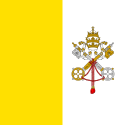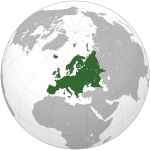Ìlú Fatikan
Ìrísí
(Àtúnjúwe láti Vatican City)
State of the Vatican City Stato della Città del Vaticano[1]
| |
|---|---|
![Ibùdó ilẹ̀ Ìlú Fatikan (green) on the European continent (dark grey) — [Legend]](http://upload.wikimedia.org/wikipedia/commons/thumb/f/f7/Location_Vatican_City_Europe.png/250px-Location_Vatican_City_Europe.png) Ibùdó ilẹ̀ Ìlú Fatikan (green) on the European continent (dark grey) — [Legend] | |
| Olùìlú | Vatican City[2] |
| Àwọn èdè ìṣẹ́ọba | Italian[3] |
| Àwọn ẹ̀yà ènìyàn | Italians, Swiss (Swiss Guards), other [4] |
| Ìjọba | Ecclesiastical,[5] sacerdotal-monarchical[6] |
| Pope Benedict XVI | |
| Giovanni Lajolo | |
| Independence from the Kingdom of Italy | |
| 11 February 1929 | |
| Ìtóbi | |
• Total | 0.44 km2 (0.17 sq mi) (233rd) |
| Alábùgbé | |
• July 2009 estimate | 826[7] (220th) |
• Ìdìmọ́ra | 1,877/km2 (4,861.4/sq mi) (4th) |
| Owóníná | Euro (€)[8] [9] (EUR) |
| Ibi àkókò | UTC+1 (CET) |
• Ìgbà oru (DST) | UTC+2 (CEST) |
| Àmì tẹlifóònù | +379[10] |
| ISO 3166 code | VA |
| Internet TLD | .va |

|
Àyọkà yìí tàbí apá rẹ̀ únfẹ́ àtúnṣe sí. Ẹ le fẹ̀ jù báyìí lọ tàbí kí ẹ ṣàtúnṣe rẹ̀ lọ́nà tí yíò mu kúnrẹ́rẹ́. Ẹ ran Wikipedia lọ́wọ́ láti fẹ̀ẹ́ jù báyìí lọ. |
Itokasi
[àtúnṣe | àtúnṣe àmìọ̀rọ̀]- ↑ Treaty between the Holy See and Italy, article 26.
- ↑ Vatican City is a city-state
- ↑ In accordance with paragraph 2 of the Legge sulle fonti del diritto of 7 June 1929, all laws and regulations of the state are published in the Italian-language Supplemento per le leggi e disposizioni dello Stato della Città del Vaticano attached to the Acta Apostolicae Sedis. The text of the first seven items published in that supplement is given here. While the state itself uses only Italian, many other languages are used by institutions situated within the state, such as the Holy See, the Pontifical Swiss Guard, and the Pontifical Academy of Sciences. The Holy See uses Latin as an official language and French as a diplomatic language; in addition, its Secretariat of State uses English, German, Italian, Polish, Portuguese and Spanish. The Swiss Guard, in which commands on parade are given in German, also uses French and Italian in all its official ceremonies. The semi-official Holy See newspaper L'Osservatore Romano uses English, French, German, Italian, Malayalam, Polish, Portuguese and Spanish. Vatican Radio uses Albanian, Amharic, Arabic, Armenian, Byelorussian, Bulgarian, Chinese, Croatian, Czech, Esperanto, English, Filipino, French, German, Hindi, Hungarian, Italian, Kiswahili, Latvian, Lithuanian, Malayalam, Polish, Portuguese, Rumanian, Russian, Slovak, Slovenian, Somali, Spanish, Tamil, Tigrigna, Ukrainian, and Vietnamese.
- ↑ "CIA - The World Factbook - Holy See (Vatican City)". Cia.gov. Archived from the original on 2020-12-23. Retrieved 2009-10-10.
- ↑ Àṣìṣe ìtọ́kasí: Invalid
<ref>tag; no text was provided for refs namedfactbook - ↑ catholic-pages.com
- ↑ Holy See (Vatican City) Archived 2020-12-23 at the Wayback Machine., The World Factbook, CIA. Retrieved 14 April 2009.
- ↑ Since 2002-01-01. www.vatican.va Holy See Press office — General Information. Retrieved 2009-10-23
- ↑ Before 2002, the Vatican lira (on par with the Italian lira)
- ↑ ITU-T assigned code 379 to Vatican City. However, Vatican City is included in the Italian telephone numbering plan and uses the Italian country code 39, followed by 06 (for Rome) and 698.
- ↑ www.vatican.va Holy See Press office — General Information. Retrieved 2009-10-23



